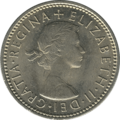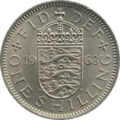Shilling (British coin) facts for kids
| United Kingdom | |
| Value | £0.05 |
|---|---|
| Mass | (1816–1970) 5.66 g |
| Diameter | (1816–1970) 23.60 mm |
| Edge | Milled |
| Composition |
|
| Years of minting | c. 1548 – 1966 |
| Obverse | |
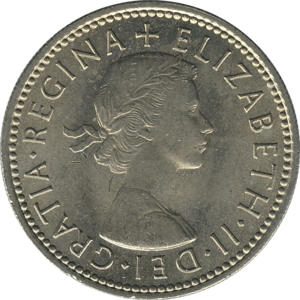 |
|
| Design | Profile of the monarch (Elizabeth II design shown) |
| Designer | Mary Gillick |
| Design date | 1953 |
| Reverse | |
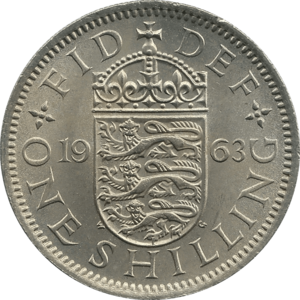 |
|
| Design | Various (coat of arms of England design shown) |
| Designer | William Gardner |
| Design date | 1947 |
The British shilling was a coin used for many years. It was worth one-twentieth of a pound. This means 20 shillings made up one pound. It was also worth twelve pence. People sometimes called it a "bob."
The shilling was first made around 1503. It was called a "testoon" back then. It became known as the shilling in the mid-1500s. These coins were used until 1990. After decimalisation in 1971, a shilling was worth five new pence. New coins of this value were made. The shilling itself stopped being legal money in 1990. For many years, shillings were made of Silver. After 1946, they were made of Cupronickel, a mix of copper and nickel.
Before 1971, British money used a system called "£sd." In this system, one pound (£) was divided into 20 shillings (s). Each shilling was then divided into 12 pence (d). Even before the coin was made, people used the value of a shilling for counting money. This was true since the early medieval period. The Normans set the value of one shilling at 12 pence after they conquered England. Before that, different English coins worth 4, 5, or 12 pence were all called shillings.
People often wrote amounts like "19/11" for nineteen shillings and eleven pence. If it was exactly five shillings, they would write "5/–".
A Look at the Shilling's History
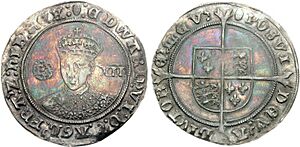
The very first coins worth 12 pence were made in 1503 or 1504. They were called "testoons." These testoons were special. They were among the first English coins to show a real portrait of the king. This is why they got their name from an Italian coin called the testone, meaning "headpiece."
Between 1544 and 1551, the silver in coins was reduced many times. This was done by King Henry VIII and King Edward VI. They wanted to get more money to pay for wars. Because of this, coins made in 1551 had much less silver. They had only one-fifth of the silver of coins from 1544. So, the value of new testoons dropped from 12 pence to 6 pence. The value of coins back then depended on the price of the metal inside them.
Later, during Queen Elizabeth I's rule, this was seen as a mistake. New coins, including the testoon (now called the shilling), had much more silver. They got their original value back.
Shillings were made during the rule of every English monarch after Edward VI. They were also made during the Commonwealth period. Many different designs appeared over the years. In 1816, the Royal Mint made a huge number of new gold and silver coins. Before this, silver coins were not made very often. The new silver coins were made of 92.5% pure silver. This is called "sterling silver." Each new shilling weighed about 5.655 grams.
In 1920, the Royal Mint changed the silver coins. They went from 92.5% silver to 50% silver. Shillings with both amounts of silver were made that year. This change happened because silver prices were rising around the world. Many countries were reducing or removing silver from their coins. By the end of 1946, silver coins were no longer made at all. This was due to high silver prices and the costs of the Second World War. New "silver" coins were then made from cupronickel. This is an alloy (mix of metals) of 75% copper and 25% nickel.
Over the years, there were many ideas to change British money to a decimal system. This means using units of 10, like our money today. These ideas didn't happen until the 1960s. By then, it was clear that a simpler money system was needed. The decision to change to decimal money was announced in 1966. The pound would be divided into 100 pence, not 240. Decimal Day was on February 15, 1971. Many new coins were introduced. Shillings continued to be legal tender (accepted as money) until December 31, 1990. They were worth 5 new pence.
How the Shilling Looked
Testoons from King Henry VII's time showed a portrait of the king facing right. Around the portrait, there was writing like "HENRICUS DI GRA REX ANGL Z FRA." This means "Henry, by the Grace of God, King of England and France." All shillings made after this had similar writing. It identified the monarch (or leader during the Commonwealth). The portrait usually switched between facing left and right for different rulers.
The back of the coin showed the Royal Arms of England. This is like a shield with symbols. Around it, there was writing like "POSVI DEVM ADIVTORE MEVM." This means "I have made God my helper."
Some testoons from King Henry VIII had a different design on the back. They showed a crowned Tudor rose. But King Edward VI's coins went back to the Royal Arms design. Starting with Edward VI, the coins also had the value "XII" (meaning 12) printed next to the king's portrait. Queen Elizabeth I and Queen Mary I's shillings were a bit different. Elizabeth's coins had the "XII" on the back, above the coat of arms. Mary's coins had no value printed at all. Some shillings from Mary's time even had the date they were made. This date was printed above the portraits of Mary and Philip.
Early shillings from King James I had different writing on the back. One said "EXURGAT DEUS DISSIPENTUR INIMICI," meaning "Let God arise and His enemies be scattered." After 1604, it changed to "QVAE DEVS CONIVNXIT NEMO SEPARET," meaning "What God hath put together let no man put asunder."
Images for kids



